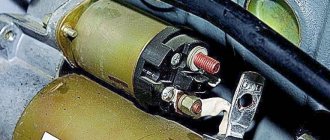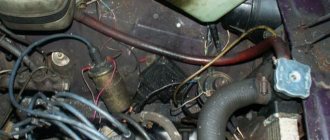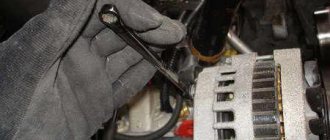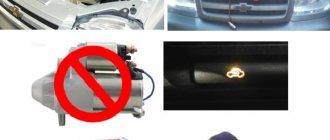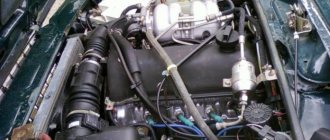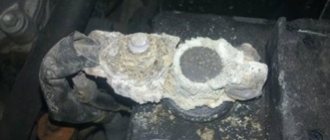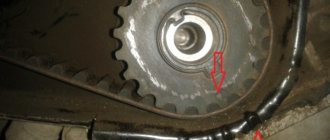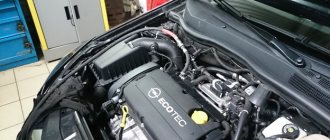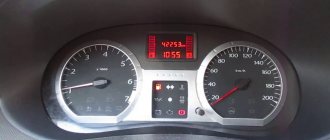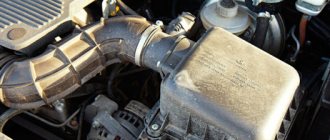The car will not start - you got behind the wheel, turned the key in the ignition or pressed the start button, but the engine does not start.
This happens with both gasoline and diesel engines, both carburetor and injection. There can be many reasons. If you understand a little about the structure of the car, you will be able to at least approximately determine the cause of the malfunction yourself. In our article, we will look at the main causes of engine starting problems, tell you how to identify them, and what to do in each case.
The battery is low
A dead battery is one of the main causes of problems starting a car engine. If the battery is completely discharged, when you try to start the engine, not a single indicator lights up on the dashboard, and the car does not show any signs of life.
If the battery is partially discharged, when you try to start the engine, the starter turns poorly, then stops turning completely, clicks of turning on the solenoid relay are heard from under the hood, and the indicators on the dashboard dim or go out completely.
The battery often discharges due to the car being left idle for a long time in a garage or in a parking lot, especially in winter. When the engine is idling, the battery does not charge well; for a normal charge, the car battery requires about an hour of continuous power. Old batteries discharge faster. Many batteries have a service life of 3-5 years, after which they must be replaced.
You can check the charge by measuring the voltage at the battery terminals with a multimeter. The voltage at the working battery terminals must be at least 12.6 Volts.
You can check whether the battery has enough power to start the engine using a load fork. The load fork simulates the load on the battery when starting the engine. The voltage at the load plug after 5 seconds of load should not fall below 9.6 Volts, which indicates 75% battery charge. A 100% charged battery has a voltage of 10.2 Volts after 5 seconds of load. You can check the battery with a load fork only at positive temperatures.
You can try to revive a slightly weak battery by turning on the high beam headlights for 2-3 seconds and then try to start the car.
If you need an urgent trip, you can start the car engine by lighting it from the battery of another car using jumper wires or from a battery starting device (booster). A car with a manual transmission can be started with a push.
In any case, even if you managed to start the car, the battery will need to be removed from the car and charged.
VAZ 2108 carburetor does not start after stopping
A fairly common question that covers not only VAZ 2109-2108 cars, but probably all VAZs in general, since problems with starting the engine happen quite often in cars of this kind.
Of course, this is a hackneyed topic, but you most likely won’t be able to get an answer to your question about why your car won’t start right away. Moreover, there can be so many reasons that diagnosis alone will take quite a lot of time. So, below are the main reasons why your car may not start.
Loose and oxidized wire connections
Over time, the connections at the battery terminals, solenoid relay, or ground wire can become loose or corroded, which can cause the car to fail to start.
To check the wire connections, open the hood and carefully inspect the battery terminals. A whitish or greenish coating around the battery terminals indicates a loose connection between the wires and the battery. A film of oxides or deposits disrupt the electrical contact and increase resistance, the current supply decreases and there is not enough of it to start the engine.
Disconnect the wire terminals from the battery terminals and clean them with fine sandpaper, a rag or brush with a soda solution, then treat them with a special spray to prevent further oxidation. Connect the wire clamps to the battery terminals and tighten them properly. The wire terminals should not rotate, much less be removed by hand.
After checking the terminal clamps on the battery terminals, also check the tip of the negative wire connecting the battery to the body and the tip of the positive wire connecting the battery to the starter. Clean oxidized contacts and tighten securely.
Regular checking of power wires and their connection points will save the car owner from a number of problems. Carry out this check yourself or ask the technician about it during your next maintenance.
Useful tips
If you can't start your carburetor engine, try a few steps. This way you can find the answer to why the engine won't start.
- Raise the hood and visually inspect the condition of your carburetor power unit.
- Check to see if all wires and terminals are securely fastened. A loose terminal or wire often became the cause of rash decisions and significant financial costs for repairs, which in practice could have been avoided.
- Assess the condition of the fuel pump. Often the cause of deterioration when trying to start the car or failure to operate is overheating of the fuel pump. Feel it. If it is too hot, it is more likely to fail. Better to replace it.
- At the same time, check the condition of the filters and oil. Perhaps it’s high time to change them, but you’re still dragging your feet on it.
Stalls while driving
If your car stalls while driving, you need to:
- Check the condition of the Hall sensor on the carburetor;
- Assess the current performance of the switch;
- If necessary, replace both elements;
- If, after the car has stalled while driving, problems arise when trying to start the engine, blow out the fuel pipes;
- If you do not receive an answer during a visual inspection and check of tubes, contacts, and other accessible components, you will have to disassemble the carburetor to find the cause;
- Be sure to adjust the carburetor. Quite often, this measure eliminates all problems. But you shouldn’t do this with your own hands. Contact a trusted carburetor specialist.
Carburetor stalls at idle
If your carburetor does not start and constantly stalls at idle, you are faced with a fairly common situation for carburetor VAZ 2109.
Here is a list of measures you can take with your own hands with the carburetor:
- Replace the needle;
- Clean the jets in the solenoid valve;
- Replace the idle speed sensor if it is faulty;
- To get rid of a stuck needle valve, which often prevents the carburetor from starting when hot, try putting a spring on it. This is a folk remedy that, oddly enough, helps;
- Check the condition of the solenoid valve, its control unit, and wiring. Make sure there is a click on it. If they are missing, the element must be replaced. Although you can try to repair it.
">] Needle valve
Source
Starter
A starter is a small electric motor that transmits the torque to the crankshaft necessary to start the engine. At the top of the starter there is a retractor relay, which is connected to the activation drive by a plug. When you turn the key in the ignition or press the start button, current from the battery is supplied to the starter, which starts the engine.
If the starter fails when you turn the key in the ignition, either clicking, buzzing, grinding or ringing sounds are heard from under the hood, or no sounds are heard at all.
The most common reasons for starter failure are: wear of brushes, bearings, drive gear jamming on the rotor splines, wear of the freewheel, oxidized or burnt contacts, short circuit of the windings.
You can check the operation of the starter by using a screwdriver to connect the thick starter terminal, to which the positive wire from the battery goes, with a small starter terminal, to which the thin wire goes. If the starter starts to rotate, then the starter control circuit, most often the ignition switch, is faulty. If the starter does not start to rotate, then the problem is in the starter itself and it needs to be repaired or replaced.
If you have access to the starter, you can try to simultaneously turn on the starter and lightly tap the solenoid relay with a wrench, which in some cases may work and the engine will start.
A car with a non-functioning starter will have to be taken to a car service center to have it repaired or replaced. You can try to push start a car with a manual transmission and drive to the service station under your own power. In most cases, the car is towed to a car service center or driven by a tow truck.
VAZ 2109 won't start
What to do if your beloved VAZ 2108 2109 21099 refuses to start? This article will discuss a troubleshooting diagram. As you probably know, for the engine to start and run, three conditions are necessary: air, gasoline, spark. When the engine crankshaft rotates, a combustible mixture is sucked into the cylinders (a mixture of air and gasoline in a certain proportion). After closing the intake and exhaust valves at the end of the compression stroke, a spark should appear on the spark plug, igniting the combustible mixture - the engine starts. Let's consider the diagnostics of identifying a fault along the chain. The entire methodology is reflected in detail in the figure; the text provides the necessary comments on the points.
Troubleshooting algorithm
1) If the starter does not turn the crankshaft of the engine number nine, then check the following: the battery must be charged, when you turn the ignition key you should hear a click of the solenoid relay operating, all connectors must be connected to the starter.
2) If the starter rotates the crankshaft, then it is necessary to determine whether a flammable mixture or a spark is entering the cylinder. First we look for a spark. To do this, remove the high-voltage wire from any spark plug, bring it at a distance of a centimeter to the ground and turn the starter.
3) If there is no spark going to the spark plug, check whether the spark is going to the ignition distributor (distributor). To do this, remove the central wire from the distributor, bring it to ground at a distance of 1 cm and turn the starter. If a spark jumps from the wire to ground, the problem is in the ignition distributor: check the slider, clean the contacts.
Checking the spark from the ignition coil
4) If there is no spark to the ignition distributor, then diagnostics of the ignition system is necessary. There are two options for further troubleshooting: A) Using a non-contact ignition system diagnostic device. B) Manual fault detection. A) You have a device, their varieties may be different, but the principle of operation is the same: power supply and operation of the Hall sensor and switch are displayed by lights.
Diagnostic device for non-contact ignition system
The device is connected to the open circuit of the switch. Remove the connector from the switch and connect it to the device connector. Place the second connector of the device on the switch. Turn on the ignition: the ignition system power light and the Hall sensor power light should be on.
When the Zhiguli starter rotates, the following should blink: the switch control light, the pulse light from the Hall sensor. If the switch control light does not blink, replace the switch.
If there are no pulses from the Hall sensor, disassemble the ignition distributor and make sure that the distributor runner rotates when the starter rotates. If the starter turns, but the distributor runner does not, the timing belt is broken. If the slider rotates but there is no signal from the Hall sensor, replace the Hall sensor. B) Option for troubleshooting without an ignition diagnostic tool. Disassemble the ignition distributor and make sure that the distributor slider rotates when the starter rotates. If it doesn't turn, the timing belt is broken. If the slider rotates, check that the distributor drum does not touch the Hall sensor. Make sure the wires and connector of the Hall sensor are in good condition. If everything is normal, change the switch; the most common reason when there is no spark is the switch burned out. If, even after replacing the switch, a spark does not appear, suspicion falls on the ignition coil and connecting wires. The ignition coil (in popular parlance) fails extremely rarely, but such cases also happen.
5) If there is a spark, but the engine does not start, remove the air filter cover.
Air filter without cover
Is the filter clean and free of oil? We try to start it without the air filter cover, if it starts, it means there is no air access to the carburetor, the filter is clogged, the air supply is filled with oil. 6) If it doesn’t start, completely remove the filter with the cap and unscrew the fuel hose from the fuel pump to the carburetor on the carburetor side. We turn the starter - gasoline should spray out. Doesn't it splash? Either the fuel pump has failed, or fuel is not supplied from the tank, if there is any there, of course. 7) If gasoline splashes when the starter rotates, unscrew the fuel return hose from the carburetor. Plug the return with your finger and blow into the supply with your mouth. Is air passing into the float chamber? If yes, then gasoline is also passing through, you need to blow out the entire carburetor with compressed air. Is there air getting into the float chamber? Check the carburetor mesh filter. We unscrew it and clean it. Did not help? — The needle valve may be stuck. Tap the side of the carburetor with a wrench or blow compressed air into the feed hole. 9) If you still cannot blow air into the float chamber, remove the carburetor cover. We take it in our hands and try to blow it again. Air does not pass through - change the needle valve. 10) If air flows through when the cover is removed, but not when it is clamped on the carburetor, the fuel jets are clogged. The carburetor needs to be completely purged. 11) If after the work done the car still does not start, unscrew the spark plugs. Look, are they filled with gasoline or not? If they are flooded, you need to dry them. Turn on the gas stove and, holding the pliers, dry the candle over the fire. If the spark plugs are still dry, you can try spraying a few drops of gasoline into chamber 1 of the carburetor (closer to the passenger compartment). The resulting vacuum may pierce the carburetor and the engine will start.
We try to start it without the air filter cover, if it starts, it means there is no air access to the carburetor, the filter is clogged, the air supply is filled with oil. 6) If it doesn’t start, completely remove the filter with the cap and unscrew the fuel hose from the fuel pump to the carburetor on the carburetor side. We turn the starter - gasoline should spray out. Doesn't it splash? Either the fuel pump has failed, or fuel is not supplied from the tank, if there is any there, of course. 7) If gasoline splashes when the starter rotates, unscrew the fuel return hose from the carburetor. Plug the return with your finger and blow into the supply with your mouth. Is air passing into the float chamber? If yes, then gasoline is also passing through, you need to blow out the entire carburetor with compressed air. Is there air getting into the float chamber? Check the carburetor mesh filter. We unscrew it and clean it. Did not help? — The needle valve may be stuck. Tap the side of the carburetor with a wrench or blow compressed air into the feed hole. 9) If you still cannot blow air into the float chamber, remove the carburetor cover. We take it in our hands and try to blow it again. Air does not pass through - change the needle valve. 10) If air flows through when the cover is removed, but not when it is clamped on the carburetor, the fuel jets are clogged. The carburetor needs to be completely purged. 11) If after the work done the car still does not start, unscrew the spark plugs. Look, are they filled with gasoline or not? If they are flooded, you need to dry them. Turn on the gas stove and, holding the pliers, dry the candle over the fire. If the spark plugs are still dry, you can try spraying a few drops of gasoline into chamber 1 of the carburetor (closer to the passenger compartment). The resulting vacuum may pierce the carburetor and the engine will start.
The techniques described above will help you start a VAZ 2108 2109 21099 in more than 90% of cases. However, in case of problems that are difficult to diagnose (the timing belt has slipped by several teeth, poor or absent compression in the engine, the carburetor is not adjusted), only a service station can help you.
Problems in the fuel supply system
A common cause of engine starting problems is fuel not getting into the engine cylinders. The engine rotates but does not start.
You can determine if there are problems in the fuel supply system by looking at the exhaust pipe when you try to start the engine. If smoke of any color comes out of the exhaust pipe when the engine starts, it means fuel is entering the engine cylinders. If there is no smoke, fuel is not entering the engine and you need to look for the reasons for this.
First of all, check whether there is gasoline or diesel fuel in the tank; it is quite possible that the fuel level in the tank is at zero, and you simply did not notice it. If you run out of fuel, call a taxi and take the canister to the nearest gas station. Previously, many drivers left without gasoline asked passing drivers to share gasoline. Nowadays, most modern cars have a gas tank design that does not allow a hose to be inserted through its neck, so this method of solving the problem with an empty gas tank is almost a thing of the past.
In cars with diesel engines, fuel that is out of season or of poor quality can thicken greatly in the cold, while the paraffins contained in it precipitate, clogging the fine filter and fuel lines. To solve this problem, you can try warming the fine fuel filter with a hairdryer, if that doesn’t help. You will have to warm up the car in a warm garage. After this, drain the remaining summer fuel and refuel with winter fuel. You can also pour a special antigel additive into the tank.
The reason that the car will not start may be a faulty fuel pump or its relay. The fuel pump may fail if the car driver has the habit of driving with a minimum amount of fuel in the tank. The fuel pump is cooled due to the fact that it is immersed in fuel; if there is little fuel in the tank, the pump overheats and may fail over time. Impurities contained in low-quality fuel or frozen water can clog the fuel pump filter screen, which will lead to problems with starting the engine.
In order to check the operation of the fuel pump, you need to listen to the buzzing sound of its operation, which comes from the rear seat, for a few seconds after turning on the ignition. To repair the fuel pump or replace its filter, you need to remove the rear seat cushion, open the hatch in the floor and then remove the pump. To perform this work, it is better to contact a car service.
Problems with starting the engine may be caused by a damaged fuel hose. Damage to the fuel hose can be determined by leaks and the smell of fuel.
Fuel system malfunction
- First of all, look at the fuel gauge on the instrument panel. There are drivers, usually newbies, who do not look at the instruments and will not always be able to find their way in the event that they simply run out of fuel.
- See if fuel is entering the system. If the car has a carburetor, prime the fuel pump manually and make sure that gasoline flows to the carburetor. If it's fuel injection, listen carefully to see if the fuel pump is running when you turn on the ignition. If not, look for the cause, a faulty fuse, an open circuit or something else that could lead to a similar outcome.
- The power system is clogged: it often happens that debris gets into the carburetor along with the fuel, and even one clogged jet can prevent normal engine starting.
Spark plug
If fuel enters the engine, but it does not start, it means that the fuel-air mixture does not ignite due to the lack of a spark. The reason for the lack of a spark may be carbon deposits or flooded spark plugs, broken ignition coils, or problems with the wires.
In order to check the condition of the spark plug, you need to unscrew it and carefully inspect its electrode. The spark plug electrode must be clean and dry. If the spark plug electrode is covered with carbon deposits or filled with gasoline, the spark plug must be wiped and dried, and replaced if necessary. A visual inspection of the spark plug may reveal that its electrode or connection connector is worn out, then the spark plug needs to be replaced with a serviceable one.
To check the operation of the spark plug, you need to put a spark plug on it, attach the thread of the spark plug so that it touches any metal part of the engine and ask your partner to crank the starter. If there is a spark, then everything is in order with the spark plugs. We check the rest of the candles in the same way. If there is a spark on all the spark plugs, then everything is fine with the ignition. If there is no spark, check the ignition coils and wires.
Cold carburetor car engine does not start
Let's consider the causes of the malfunction - why a cold (not warmed up) carburetor engine of VAZ 2108, 2109, 21099, 2105, 2107 cars does not start. The main culprits will be carburetors 2108, 21081, 21083 Solex, 2105, 2107 Ozone. It should be noted that there are also reasons why a car engine does not start in cold weather, but there is a separate article on our website to describe them. You should also pay attention to the ignition system (2108, 2109, 21099, 2105, 2107), power system, serviceability of the engine itself, etc.
Symptoms of the problem “A cold carburetor engine does not start”
— When the crankshaft is cranked by the starter, the engine does not start. He shows no signs of life. There are no flashes in the cylinders.
Problems with the immobilizer or alarm
In some cases, the car may not start due to the fuel pump, injectors, ignition system or starter being blocked by the immobilizer or alarm system. This can happen due to equipment failures or accidental pressing of the key fob in your pocket, as a result of which the anti-theft protection is activated.
Modern cars equipped with push-button ignition require the key fob to be located inside or near the car, otherwise the engine will not start. Check whether the car sees the key, key fob or tag.
Try setting the car alarm again and then disarming it. Check the battery in the key fob, it may be low and needs to be replaced.
If none of the above helps, the only thing left to do is contact a service to diagnose the key/key fob or an alarm installer.
Useful tips
If you can't start your carburetor engine, try a few steps. This way you can find the answer to why the engine won't start.
- Raise the hood and visually inspect the condition of your carburetor power unit.
- Check to see if all wires and terminals are securely fastened. A loose terminal or wire often became the cause of rash decisions and significant financial costs for repairs, which in practice could have been avoided.
- Assess the condition of the fuel pump. Often the cause of deterioration when trying to start the car or failure to operate is overheating of the fuel pump. Feel it. If it is too hot, it is more likely to fail. Better to replace it.
- At the same time, check the condition of the filters and oil. Perhaps it’s high time to change them, but you’re still dragging your feet on it.
Stalls while driving
If your car stalls while driving, you need to:
- Check the condition of the Hall sensor on the carburetor;
- Assess the current performance of the switch;
- If necessary, replace both elements;
- If, after the car has stalled while driving, problems arise when trying to start the engine, blow out the fuel pipes;
- If you do not receive an answer during a visual inspection and check of tubes, contacts, and other accessible components, you will have to disassemble the carburetor to find the cause;
- Be sure to adjust the carburetor. Quite often, this measure eliminates all problems. But you shouldn’t do this with your own hands. Contact a trusted carburetor specialist.
In practice, a carburetor may not start well for a variety of reasons. Some of them are not related to the engine itself. Therefore, the optimal solution is a full diagnostics at a car service center.
Carburetor stalls at idle
If your carburetor does not start and constantly stalls at idle, you are faced with a fairly common situation for carburetor VAZ 2109.
Timing belt
The timing belt is an important part of a car engine; it transmits torque from the crankshaft to the camshaft, ensuring the synchronization of the valves and pistons. After a certain mileage, the timing belt must be replaced; most often, the belt is replaced during routine maintenance of the vehicle.
The timing belt can stretch and jump several teeth, resulting in poor valve timing and the inability to start the engine.
A broken timing belt leads to damage to the valves, and in some cases damage to the pistons and other important engine components. A worn timing belt often breaks when starting the engine due to increased loads when cranking a frozen engine.
A car with a slipped or broken timing belt will have to be taken to a car service center for repair. You will have to deliver the car to the service station by tow or tow truck.
Sensors
The engines of modern cars are equipped with a large number of electronic sensors that transmit information to the electronic engine control unit.
The most important sensors in a car are: crankshaft and camshaft position sensors, idle speed sensor, mass air flow sensor, coolant temperature sensor, knock sensor, throttle position sensor.
If at least one of the sensors fails, the car engine either operates in the wrong mode or does not start at all. When one of the sensors fails, the Check Engine light on the vehicle's dashboard lights up.
The best way to solve a problem with a non-working sensor is to contact a car service center, where comprehensive electronic diagnostics will be carried out, as a result of which the non-working sensor will be detected and replaced.
Differences between carburetor and injector breakdowns
There are common cases of engine starting failure for the injector and carburetor. But now let’s look at the distinctive features of such a malfunction as a “stalled engine”. The differences in troubleshooting are due to the different operating principles of the two systems.
The VAZ 2109 has a carburetor - the engine is driven by sucking the combustible mixture into it. This occurs due to the fact that a pressure difference is formed in the intake manifold and the atmosphere. In this case, three components are sufficient to start the machine normally:
The starter rotates the crankshaft, and the resulting mixture (fuel and air) is sucked into the cylinder cavity. Next, the valves of the internal combustion engine close, a compression stroke occurs, at the end of which a spark appears on the spark plug and the combustible mixture is ignited. The engine starts.
And in the case of an injector, fuel injection and the quality of the resulting mixture are controlled and adjustable. The combustible mixture is pumped into the cylinders using nozzles (directly into the combustion chamber). Therefore, there is no need to create conditions for the absorption of air and gasoline here.
A breakdown in an injection engine can be briefly described as follows: either a spark does not form, or access to the cylinders is blocked for the combustible mixture.
In addition, the VAZ 2109 injector has many sensors, an electronic control unit and an electric fuel pump. They can also fail. Let's consider the procedure for finding a breakdown separately for the carburetor and injector.
Sometimes an injection car does not want to start due to shedding of the catalyst in the muffler. It serves to reduce harmful emissions and is installed in accordance with current environmental legislation on all cars.
When the catalyst crumbles, the gases cannot escape normally, which means that the car will not move, since the computer will not allow it to start. It is not difficult to check this possibility - unscrew the muffler mount so that the exhaust comes directly from the resonator. If this helps, then change the catalyst.
Control block
The electronic engine control unit is one of the most important elements of a modern car. The electronic control unit reads information from a large number of sensors that the engine is equipped with and controls all processes in the engine, including its starting.
The electronic engine control unit controls the ignition, analyzes the throttle position6, controls fuel injection processes, controls the variable valve timing system, controls the coolant temperature, and controls the exhaust gas recirculation system.
The electronic engine control unit is an electronic board that is housed in a plastic or metal housing. The engine control unit can be installed in the engine compartment or inside the vehicle, in the area of the center panel on the driver or passenger side. The installation location of the engine control unit is indicated in the vehicle's operating manual.
Malfunctions of the electronic engine control unit occur due to strong mechanical shock or vibration, which results in cracks in the electronic board or contact points, severe overheating of the electronic unit or sudden temperature changes, moisture on the electronic board and connectors, resulting in corrosion of the housing and connectors of the control unit. In some car models, the engine control unit is located extremely poorly; after just a few years of operation, it undergoes very severe corrosion and then fails.
The electronic engine control unit may fail due to incorrect actions by the car owner: removing the battery terminals with the engine not turned off, trying to light the car from another car with the engine not turned off, trying to start the engine with a connected battery with the terminals mixed up.
Malfunctions of the electronic engine control unit in most cases are solved in the only possible way: by expensively replacing the electronic unit with a new one.
Useful tips
If you can’t start a carburetor engine, you should try the following:
- lift the hood and perform a visual inspection of the carburetor;
- Check the secure fastening of all terminals and wiring. After all, sometimes the problem is in a loose terminal, therefore, without checking it, the entire carburetor is subject to repair. Financial costs increase significantly;
- Sometimes the cause of poor starting of the car is overheating of the fuel pump. If it is too hot, it may soon fail, and it is better to purchase and install a new one;
- At the same time, it is necessary to evaluate the performance of oil filters.
Generator
A generator is a device that converts part of the engine's energy into electric current, which is also used to charge the battery.
If the generator fails, the battery does not charge at all or is undercharged, resulting in the battery not having enough charge to start the engine.
The best way to solve a problem with a non-working generator is to contact a car service center, where it will be repaired or replaced. You will have to deliver the car to the service station by tow or tow truck.

